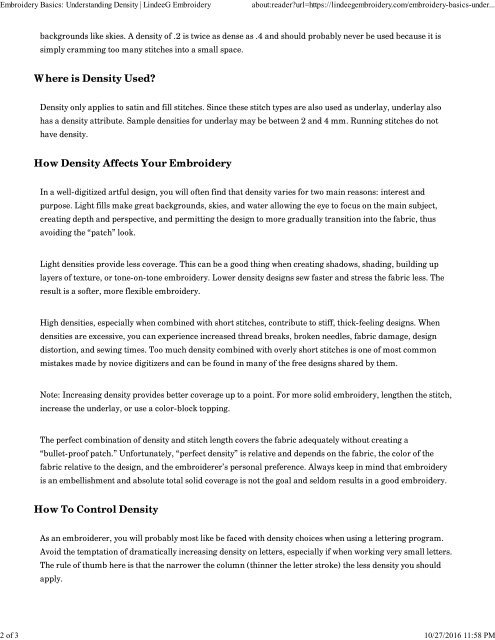Compiled Embroidery Skill Articles
You also want an ePaper? Increase the reach of your titles
YUMPU automatically turns print PDFs into web optimized ePapers that Google loves.
<strong>Embroidery</strong> Basics: Understanding Density | LindeeG <strong>Embroidery</strong><br />
about:reader?url=https://lindeegembroidery.com/embroidery-basics-under...<br />
2 of 3 10/27/2016 11:58 PM<br />
backgrounds like skies. A density of .2 is twice as dense as .4 and should probably never be used because it is<br />
simply cramming too many stitches into a small space.<br />
Where is Density Used?<br />
Density only applies to satin and fill stitches. Since these stitch types are also used as underlay, underlay also<br />
has a density attribute. Sample densities for underlay may be between 2 and 4 mm. Running stitches do not<br />
have density.<br />
How Density Affects Your <strong>Embroidery</strong><br />
In a well-digitized artful design, you will often find that density varies for two main reasons: interest and<br />
purpose. Light fills make great backgrounds, skies, and water allowing the eye to focus on the main subject,<br />
creating depth and perspective, and permitting the design to more gradually transition into the fabric, thus<br />
avoiding the “patch” look.<br />
Light densities provide less coverage. This can be a good thing when creating shadows, shading, building up<br />
layers of texture, or tone-on-tone embroidery. Lower density designs sew faster and stress the fabric less. The<br />
result is a softer, more flexible embroidery.<br />
High densities, especially when combined with short stitches, contribute to stiff, thick-feeling designs. When<br />
densities are excessive, you can experience increased thread breaks, broken needles, fabric damage, design<br />
distortion, and sewing times. Too much density combined with overly short stitches is one of most common<br />
mistakes made by novice digitizers and can be found in many of the free designs shared by them.<br />
Note: Increasing density provides better coverage up to a point. For more solid embroidery, lengthen the stitch,<br />
increase the underlay, or use a color-block topping.<br />
The perfect combination of density and stitch length covers the fabric adequately without creating a<br />
“bullet-proof patch.” Unfortunately, “perfect density” is relative and depends on the fabric, the color of the<br />
fabric relative to the design, and the embroiderer’s personal preference. Always keep in mind that embroidery<br />
is an embellishment and absolute total solid coverage is not the goal and seldom results in a good embroidery.<br />
How To Control Density<br />
As an embroiderer, you will probably most like be faced with density choices when using a lettering program.<br />
Avoid the temptation of dramatically increasing density on letters, especially if when working very small letters.<br />
The rule of thumb here is that the narrower the column (thinner the letter stroke) the less density you should<br />
apply.




